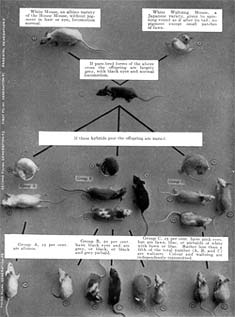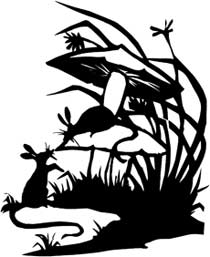|
 House Mouse: The American white-footed mouse (Peromyscus leucopus) and the deer mouse (Peromyscus maniculatus) also sometimes live in houses. These species of mice live commensally with humans. Although they may live up to two years in the lab, the average mouse in the wild lives only 3 months, primarily due to heavy predation. Cats, wild dogs, birds-of-prey, and snakes prey heavily upon mice. House Mouse: The American white-footed mouse (Peromyscus leucopus) and the deer mouse (Peromyscus maniculatus) also sometimes live in houses. These species of mice live commensally with humans. Although they may live up to two years in the lab, the average mouse in the wild lives only 3 months, primarily due to heavy predation. Cats, wild dogs, birds-of-prey, and snakes prey heavily upon mice.
 Mice as pests: Mice can be harmful pests, damaging and eating crops and spreading diseases through their parasites and feces. The original motivation for the domestication of cats is thought to have been for their predation of mice and their relatives, the rats. Mice as pests: Mice can be harmful pests, damaging and eating crops and spreading diseases through their parasites and feces. The original motivation for the domestication of cats is thought to have been for their predation of mice and their relatives, the rats.
The Real House Mice: House mice are light brown to black, with short hair and a light belly. Laboratory mice and pet mice are often white. The ears and tail have little hair. Adults weigh some 12 to 40 grams; their body (including tail) is about 15-19 centimeters long, with the tail usually accounting for a bit more than half of it.
Male or Female: Young males and females are not easily distinguished; females have a significantly smaller distance between their anus and genital opening. When sexually mature, the most striking and obvious difference is the presence of testicles on the males. These are relatively large compared to the rest of the body, being approximately half the size of the mouse's skull and usually hairless. They can be retracted into the body. Females have 5 pairs of mammary glands and nipples; males have no nipples.
Harderian glands: House mice have Harderian glands near their eyes which produce a reddish-brown discharge when the animals are stressed.

Second only to man: The house mouse is believed to be the second most populous mammalian species on Earth, after man. House mice almost always live in close proximity of humans. Laboratory mice are strains of house mice that
form important  model organisms in biology and medicine; model organisms in biology and medicine;
they are the most commonly used laboratory mammal.
House mice usually walk, run or stand on all fours, but when eating, fighting or orienting themselves, they stand only on the hind legs, supported by the tail. When running, the horizontal tail serves for balance; the end stands up vertically, unless the mouse is frightened. Mice are good jumpers, climbers and swimmers.
Night Owls: Mice are mostly active during dusk or night; they do not like bright lights. They live in a wide variety of hidden places that are near food sources and construct nests from various soft materials. Mice are territorial and one dominant male usually lives
together with several females and young. Dominant males respect each other's territory and normally enter another's territory only if it is vacant. If two or more males are held together in a cage, they will often turn aggressive unless they have been raised together from birth.
You Eat Like a Mouse: House mice primarily feed on plant matter, but they will also accept meat and dairy products. They will drink water but require little of it, relying mainly on the moisture present in their food. They will eat their feces to acquire nutrients produced by bacteria in their guts. House mice, like the other rodents, do not vomit.
Rats Eat Mice? Mice are afraid of rats, which often kill and (partially) eat them. This rat behavior is known as muricide.
Uncommon Sense: As primarily nocturnal animals, house mice have little or no color vision. They have a sharp sense of hearing and can perceive ultrasound, possibly up to 100kHz. They communicate both in the human audible range with squeaks (for long-distance warnings), and in the ultrasound range (for short-distance communication).
The mice can sense surfaces and air movements with their whiskers.

The Mouse in Research: Usually genetically uniform strains of mice are used in experiments. These inbred strains are commonly created by mating closely related mice, such as brothers and sisters, for over twenty consecutive generations.
Except for sex differences, two mice belonging to the same inbred strain are nearly genetically indistinguishable.
They are also homozygous at all genetic locations. As genetic variation is minimized, experiments using inbred mice have the potential for to be highly repeatable and are especially valuable in genetic crosses.
Inbred Mice: As in inbred human populations, inbred mice often show characteristics that are not common in the wild. This is usually due to the appearance recessive alleles of genes that are masked by dominant alleles in more heterogeneous populations. Sometimes these characteristics may be predispositions towards certain diseases. Other times they may be protections from disease. For instance, the C3H strain develops hardened arteries much less often than ordinary mice. These predispositions vary widely between inbred strains depending. This often facilitates studying particular diseases, though one must carefully select strains for use in disease models based on the susceptibilities each strain exhibits. As a result, one downside of using inbred mice is that they are not representative of "wild" mice and in many cases may make poor models for human biology.
 The "Nude" Mouse: One interesting inbred strain is the nude mouse. Nude mice bear mutations that result in a lack of hair and an impaired immune system, particularly the lack of lymphocyte populations. Nude mice can be used in cancer studies because they do not reject cells and tissue from other mice or even other species, which can be tested in the mouse for tumor-forming capacities. The "Nude" Mouse: One interesting inbred strain is the nude mouse. Nude mice bear mutations that result in a lack of hair and an impaired immune system, particularly the lack of lymphocyte populations. Nude mice can be used in cancer studies because they do not reject cells and tissue from other mice or even other species, which can be tested in the mouse for tumor-forming capacities.
Knockout Mice: Knockout mice are mice which have had a specific gene or genes inactivated, either through deletion or disruption of the portion of the genome containing the gene in question. This enables the study of the function of that gene and genes interacting with it. Knockout mice have aided the study of many conditions including heart disease, diabetes, cancer, obesity, arthritis, and Parkinson's disease. Some genes are essential for survival; it is impossible to create viable mice without working copies of these genes. To circumvent this, conditional knockout mice have been developed. In these animals, the gene to be studied may be knocked out only in specific tissues or at specific stages in development. Thus, viable mice lacking the gene of interest may be generated.

Birds and Bees: Female house mice have an estrous cycle that is 4-6 days long, with estrus itself lasting less than a day. If several females are held together under crowded conditions, they will often not have an estrus at all; if they are then exposed to male urine, they will become estrous after 72 hours.
 Singing Mice: In 2006, Scientists at the University of Washington discovered that male mice and rats actually make high-pitched songs to attract females of their species for mating. Singing Mice: In 2006, Scientists at the University of Washington discovered that male mice and rats actually make high-pitched songs to attract females of their species for mating.
Ultrasonic Calls: Male house mice court females by emitting characteristic ultrasonic calls in the 30kHz - 110kHz range. The calls are most frequent during courtship when the male is sniffing and following the female.
However, the calls continue after mating has begun at which time the calls are coincident with mounting behavior. Males can be induced to emit these calls by female pheromones.
The vocalizations appear to be different in different individuals and have been compared to birdsongs because of their complexity. While females have the capability to produce ultrasonic calls, they typically do not do so during mating behavior.
Mini-mice: One female can have some 5-10 litters per year, so their population can increase very quickly. Breeding occurs throughout the year (however, animals living in the wild don't reproduce in the colder months, even though they don't hibernate). The newborn are blind and furless. Fur starts to grow some three days after birth and the eyes open one to two weeks after birth. Females reach sexual maturity at about 6 weeks and males at about 8 weeks, but both can breed as early as 35 days.
 Harsh Reality: House mice usually live under a year in the wild, because of a high level of predation and exposure to harsh environments. In protected environments, however, they often live two to three years. Harsh Reality: House mice usually live under a year in the wild, because of a high level of predation and exposure to harsh environments. In protected environments, however, they often live two to three years.
The Methuselah Mouse Prize is a competition to breed or engineer extremely long-lived laboratory mice. As of 2005, the record holder was a genetically engineered mouse that lived for 1819 days, nearly 5 years.
Another record holder that was kept in a stimulating environment but did not receive any genetic, pharmacological or dietary treatment lived for 1551 days, over 4 years.
All text is available under the terms
of the GNU Free Documentation License |